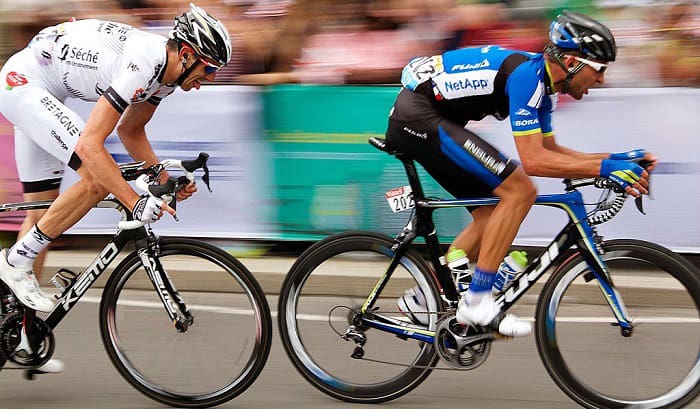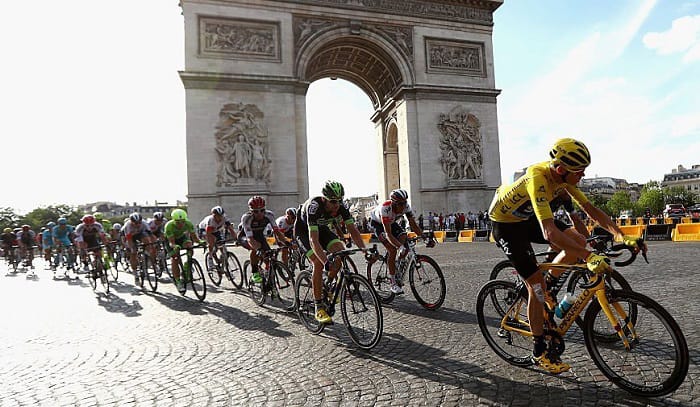The Tour de France represents the best that competitive cycling has to offer. While it is known for the skill that competitors need to win, people are naturally curious about the details related to the event.
One such aspect is the bicycle weight. How much do Tour de France bikes weigh?
Different designs vary in weight, but the bicycles in the competition do not go below 6.8kg. Let’s get to know this magic number along with other interesting information.
Table of Contents
The Weight of Tour De France Bicycles
6.8 is a number that seems closely tied to the Tour de France, being the common weight of a bike in kg. While this is a well-known Tour de France fact, other circumstances related to this number are not as famous.
Not all bicycles are at this specified weight, since it’s only a minimum mass requirement, and participating bikes are not expected to hit that mark exactly.
However, a lighter weight usually means better performance in sports, so the lightest allowable weight is desirable.
That said, a lightweight bike does not always mean being able to ride at faster speeds. It turns out that bicycles that are too light end up facing more air resistance, which keeps them from going faster.
This fact is why a balance between heft and aerodynamics is important, with such bikes able to cut through the air.
For comparison, exercise bikes like Peloton weigh 62kg, which equals around 10 Tour de France bicycles. The power wheel weight limit for toddlers is 18kg and is still well above the Tour’s weight rule. This is how light 6.8kg is.
Weight Specification
- The minimum weight requirement was introduced in the year 2000 by the UCI, the tour’s governing body, as a way to keep cyclists safe.
The idea is to keep manufacturers from producing bikes that are too light, which would result in higher risks of the rider losing control.
- While the 6.8kg minimum was established, no maximum weight has been specified. But to give you a ballpark, the heaviest bicycles weigh over 9kg but do not exceed 10kg.
- To determine the Tour de France bicycle weight limits, the UCI assembled an Equipment Commission composed of engineers and industry experts. Based on research and a thorough review of data, they came up with the magic number of 6.8kg.
The problem with imposing weight regulations is that modern technology brings about change.
In this case, the advent of lightweight but sturdy materials resulted in bicycles becoming lighter with frames made of carbon fiber and the like.
While many bikes in recent years were well below the specified weight requirement, this has not prevented anyone from using them in the tour. Electronic shifters have been used frequently to boost the overall weight, with the batteries ensuring rule compliance.
Tour De France Cycle Types
Like any other race, the Tour de France involves clearing the entire length of the specified course as quickly as possible.
However, since this event consists of 21 stages in around 3 weeks, teams need to have multiple bikes to deal with equipment problems.
There is also the matter of the different types of terrain where competitors will have to pass, and having the right bicycle for the job makes a ton of difference.
In the current format, three main types of bikes prove useful, with each one geared for a specific stage.
- Road bike
This bike is well-suited for paved road sections with its lighter and smaller frame coupled with lighter and narrow wheels. These bikes have changed much over the years with the arrival of specific subtypes.
The aero bike is a specialized road bike and is designed to incorporate aerodynamics for better maneuverability. It is often used for competitions, and while it is faster due to its specialized build, more aerodynamics makes this subtype heavier, so striking a balance is key.
More recently, however, traits of bicycle kinds are becoming more varied while manufacturers pursue the best combination of features for competitive cycling.
- Climbing bike
Bicycles need two things to climb well: lightness and stiffness. Being lightweight is always an important point, but climbing bikes still need their fair share of aerodynamics to balance things out.
The other important factor is stiffness, which refers to the frame being resistant to bending. This is not just about the bike surviving the strain of the climb; a stiff frame allows for better power transfer when pedaling, meaning you do not waste any energy.
Keeping the wheels in prime position is crucial, and this is what climbing bicycles are designed to do well.
- Time Trial bike
Time Trial (TT) stages are quite different from the other stages in the tour, and the bicycles for such sections are adjusted to fit their demands.
The TT bike is similar to a road bike but with a shifted priority, leaning toward aerodynamics more than balance and control.
The benefit is that this type can cut through air while reducing resistance better. While the downside is a reduction in control and being less comfortable, this is offset by the fact that solo time trials see riders start alone instead of with every other participant.
Many argue that this event is a purer race compared to the traditional stages and can truly highlight a rider’s skill.
Another major difference is that TT bikes end up being heavier than other tour bicycles due to the focus on aerodynamics. At an average weight of 9kg, this is a huge difference from the 6.8kg minimum.
Frequently Asked Questions
Are all bikes in the Tour de France 6.8kg in weight?
No, this is not what every bicycle weigh in grams or kg. As mentioned above, many are well below the requirement but meet it with added weight from parts.
Some bikes are also heavier, especially time trial models that rely on aerodynamics at the cost of additional load.
What is the lightest bike in the Tour de France?
In the Tour de France bike weight history, the lightest one is 6.8kg, which is not an exciting answer. The minimum weight rule was implemented in 2000, when bikes could not be as light as they can be today.
You could say that the UCI prevented Tour de France bicycles from being historically lighter by imposing the limit well before it was easy to achieve.
Is 6.8kg a hard limit?
No, it is not absolute, and participants are given a 100g allowance. This is to account for the scale difference that may be present between bicycle owners and the UCI.
Conclusion
How much do Tour de France bikes weigh? Now, you know all about it and the all-important 6.8kg requirement.
It sounds weird to have a minimum weight and not a maximum, but it does make more sense when considering the reasons for implementing such a requirement.
What do you think about this rule? Let us know by leaving a message in the comments section below. We’ll be waiting to hear from you.
Always ride safely.

“I ride my bike to work for years, but is that enough? Our carelessness towards our surroundings has taken a toll on the environment. And now, everyone is responsible for changes; even the most minor contribution is counted. With this hope and spirit, I started with my partner to establish Biketoworkday to help more individuals commute to their work sites on their bikes.”




